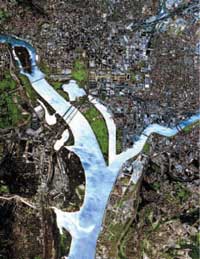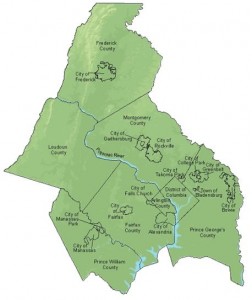Will the regional transit system be up to the challenge of meeting the Transportation Planning Board (TPB) Vision’s objectives and the Greater Washington 2050 Coalition Region Forward’s targets, especially for a higher transit mode share in 2040?

Image from mwcog.org
In early 2010, the Metropolitan Washington Council of Governments endorsed Region Forward. It includes goals, objectives and targets for the metropolitan area in 2050, relating to accessibility, sustainability, prosperity and livability. Transportation is one of nine categories among its goals, and the transportation targets draw heavily from the TPB Vision that was adopted in 1998. The Regional Transit System Plan (RTSP) is intended to help develop strategies to achieve Region Forward’s goals, objectives and targets. Several of these targets are focused on transit, and are compatible with the goals of the RTSP. What follows is a listing of Region Forward’s transit-focused goals, and how a future including an implemented RTSP may help achieve them.
Priority for management, performance, maintenance, and safety
This target echoes an objective in the TPB Vision and is intended to insure that investment in existing transportation infrastructure continues as a top priority. For example, Virginia’s funding for roads follows this philosophy, by funding road maintenance and operations off the top of revenues. That philosophy would be advantageous for transit, too, so that investments in new infrastructure wouldn’t result in disinvestment in the existing bus and rail infrastructure that continues to be needed.
RTSP is evaluating an “Enhanced Surface Transit” strategy, in which the network of 24 Metrobus Priority Corridors (PCN’s) are enhanced with bus priority treatments, intended to increase performance of surface transit service in the region while reducing overall operating costs. The RTSP will also look into new surface transit connections with an eye towards interoperability, which would help reduce costs of managing and maintaining different new light rail and streetcar systems. Read more…
 The purpose of the Regional Transit System Plan (RTSP) for 2040 is to serve as the long range transit plan including multi-modal access for the District of Columbia, Maryland, and Northern Virginia. The RTSP sets the following four project goals for the development of a comprehensive transit system plan for the region:
The purpose of the Regional Transit System Plan (RTSP) for 2040 is to serve as the long range transit plan including multi-modal access for the District of Columbia, Maryland, and Northern Virginia. The RTSP sets the following four project goals for the development of a comprehensive transit system plan for the region:
- Core Capacity – Increasing current transit capacity to the core to meet current and projected future demand and promote continued employment growth
- System Access – Improving current station access for pedestrians, cyclists, bus and automobile operators
- Surface Transit Corridors – Providing priority for surface transit corridors including express bus on HOV, rapid bus on arterials, light rail, and streetcar projects
- New and Emerging Markets – Identifying, connecting, and improving transit access to regional activity centers
What is the Technical Advisory Group (TAG)
 The RTSP Technical Advisory Group (TAG) is convened for the express purpose of reviewing the work products, data and recommendations developed by the RTSP study team during the planning process. The TAG members will be responsible for providing the team with timely information, briefing their respective organizations and informing the team of current transportation plans, proposals and operations which are relevant to the development of the RTSP 2040.
The RTSP Technical Advisory Group (TAG) is convened for the express purpose of reviewing the work products, data and recommendations developed by the RTSP study team during the planning process. The TAG members will be responsible for providing the team with timely information, briefing their respective organizations and informing the team of current transportation plans, proposals and operations which are relevant to the development of the RTSP 2040.
Read more…
 Frequently Asked Questions (FAQ’s)
Frequently Asked Questions (FAQ’s)
1. What is the Regional Transit System Plan (RTSP) 2040?
The Regional Transit Systems Plan (RTSP) for 2040 is a study of the region’s future transit needs, developed with input and guidance from all of the WMATA signatories, which, upon completion, will result in a long range multi-modal, transit system plan for the District of Columbia, Maryland, and Northern Virginia.
2. What transit modes does the RTSP include?
The RTSP will evaluate the impact of all modes of transit including: local bus, express bus, streetcar, light rail and heavy rail. Additionally, the RTSP will identify opportunities to enhance efficiencies of the aforementioned modes by providing improved access to pedestrians, bicycles and single-occupancy vehicles (SOV’s) at transit facilities (i.e. stations, stops, etc.).
Read more…



 The RTSP Technical Advisory Group (TAG) is convened for the express purpose of reviewing the work products, data and recommendations developed by the RTSP study team during the planning process. The TAG members will be responsible for providing the team with timely information, briefing their respective organizations and informing the team of current transportation plans, proposals and operations which are relevant to the development of the RTSP 2040.
The RTSP Technical Advisory Group (TAG) is convened for the express purpose of reviewing the work products, data and recommendations developed by the RTSP study team during the planning process. The TAG members will be responsible for providing the team with timely information, briefing their respective organizations and informing the team of current transportation plans, proposals and operations which are relevant to the development of the RTSP 2040.
Recent Comments